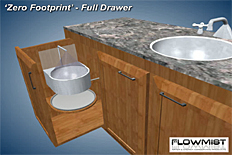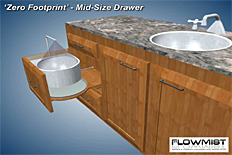LIFE'S RESOURCES ARE PRECIOUS...
By the end of 2014 over two-thirds of the 50 states in the US will face water shortages. Over 800 million people worldwide will not have a sufficient supply of water. How can we help? Applying new innovations in water-conserving products can bring unprecedented water savings easily within our reach. Think: Billions of gallons of water per day.
LEAD an Industry wIth 0.5 to 1.0 oz
Self-Rinsing SmartHome Technology
Available: Three Issued Patents - Others Pending
Featuring 'IoT' Wireless-Device Interactivity & Control
for Homes and Commercial Installations
Microdroplet-Wetting Magic: It used to be that the 'low-flush' gold standard for urinals was 1 to 1.5 gallon per flush 'gpf' (128-192 oz). Then, improved water-flushing techniques brought water-use per flush rates well into 0.5 gpf range (64 oz), with some newer approaches achieving 1/8th gallon / 16 oz flushing. We felt there was still room for improvement with Flowmist's patented microdroplet-wetting self-rinsing action. So we set about designing, developing and testing our misting-urinal approach which--with final tweaking--yielded two approaches resulting in just 0.5 - 1 oz (1 -2 tablespoons) of water per use-cycle / self-rinsing. Think of a 12 oz can of soda filled with water. Imagine getting 12 to 24 pre-wetting and full use-cycles from just that one 12 oz can.
Why it Works: FlowMist's microdroplet-wetting technique pre-conditions a urinal-receptacle seconds prior to use and throughout each use-cycle. The 'magic' of the micro-droplets is that they predispose the receptacle surface to instantly repell waste liquids and any associated odor, facilitating realtime self-rinsing at record levels of water-saving efficiencies: 0.5 to 1 oz (that's 0.0039 to 0.0078 gpf -- a 16x to 32x improvement over the previous 1/8th (0.125) gpf market leader.
* Based on half-minute average use-cycles
Clean, Green and Seldom-Seen
Now in Zero-Footprint & 'Wireless' Models Too
NEW 'Zero-Footprint' Issued Patent In-Wall / In-Cabinet Models: FlowMist's Increase Sales Revenue: Installable on New, Upgraded, Facade-Makeover or Existing Cabinet Doors and Drawers and Connect Easily with Sink Plumbing. Bringing endless options to customers for saving billions of gallons of water,
and all the energy required to move it.

Click image above to go to our 'Zero-Footprint' - Self-Rinsing Urinal videos
Toilet Flushing Using Up to 30% of Water in Homes - So the good news is there's a new ultra-low water-usage urinal using just 1 to 2 tablespoons of water per use-cycle. How can it be applied in new ways to make a REALLY BIG difference? We took a close look at the residential sector and here's what we found out. According to a Natural Resources Defense Council report titled 'Energy Down the Drain' --"Toilet flushing represents the largest single use of water inside the home. While older toilets use as much as 6 gallons per flush, federal and state water-efficiency laws now standardize flush volumes at a maximum of 1.6 gallons per foot for all new toilets." What about energy use? Other reports show states allocating up to one-fifth of their electrical energy just on water-related electricity (e.g., supply, conveyance and treatment). Such reports made it clear to us that a new urinal approach, manufactured easily, aesthetically and concealably installable in new homes, or retrofitted in existing homes -- literally could save billions of gallons of water every month. For example, new and existing homes and businesses could flush a FlowMist wall-mount or cabinet 'Seldom Seen' urinal up to 128 to 256 times for every gallon of water used by a low-flush urinal, or over 400+ times relative to the current average water use-rate of toilets in the U.S.
The Genesis of Our Going 'Zero-Footprint' - A really big challenge facing water-usage reduction in residences has been the difficulty in accommodating homes with practical urinal installation or retrofit options. Bathrooms and restrooms are often utilitarian in design -- leaving little or no room to add another plumbing appliance.
Another issue has been a concern that urinals (like most toilets) are not especially attractive to look at. So some of our first design questions were: "How could we use as little space as possible? Could we require no space? How might we provide the cleanest, most aesthetically pleasing solution available? Which lead to $64k question: "Who says toilets (or urinals in our case) always have to be mounted right in plain view?" Careful consideration of each of these questions lead us to our New 'Zero-Footprint' Solutions -- ideally incorporating our patented ultra-low water-usage urinals into existing, newly installable (or into customary) cabinetry of a room. See patent 8,561,219
To See Our FlowMist Wall-Mount Urinals:
Check out our Gallery - Page
On the commercial side: according to GreenBiz.com, commercial buildings alone use an estimated 9.5 billion gallons of water each day. According to the U.S. Department of Energy "Toilets and urinals account for nearly one-third of building water consumption, making the savings potential in this area significant."
Take a look at our Videos - Page and see for yourself how easy it can be to incorporate FlowMist ultra-low water-usage solutions into new or existing homes or businesses, and help us contribute to the saving of billions of gallons of water daily.
Gallons? How About 0.5- 1 Ounce
1 - 2 Tablespoons of Water per half-minute use-cycle

Troubles With Waterless Reported:
1. The Disadvantages of Waterless Urinals, eHow.com
"Waterless urinals are intended to conserve the billions of gallons of water that flush urinals use each year in the U.S. While they have the potential to greatly conserve natural resources, there are disadvantages to waterless urinals, particularly in installation costs, training requirements, maintenance costs and potential chemical damage..." Read More!
2. Copper Pipes Must be Torn Out, Replaced with PVC
"Chicago's building code require commercial buildings to use copper pipes in indoor plumbing. But the U.S. Army Corps of Engineers specifically states that drainpipes for waterless urinals "cannot be made of copper pipe, which corrodes..." Read More!
3. 'Green' Experiment at City Hall Stinks - Chicago Sun-Times
"Waterless urinals installed to promote water conservation in the public men's room outside the City Council chambers have turned into a stinky mess. The odor got so bad that the "green" urinals are now being ripped out and replaced with the old-fashioned kind at a cost City Hall has refused to disclose." Read More
See How -- Supply, Conveyance, Treatment of Water can be Energy (and CO2-Emission) Intensive
In the water use cycle, water supply, conveyance, treatment, wastewater collection, treatment and discharge, and recycled water treatment and distribution, add up fast in terms of energy overhead and air quality / emission-related consequences. See this Water Energy Sustainability Symposium PDF to get a quick overview. You'll see how moving water around is a BIG deal, and also see how arid regions in particular pay dearly in energy for water.








